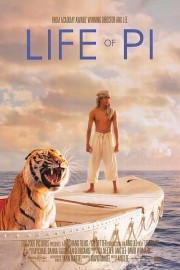Life of Pi
**Spoiler Alert: Some aspects of “Life of Pi’s” story must be gone into in order for me to review it properly. You’ve been warned.**
Ang Lee’s “Life of Pi” is one of the most visually-stunning films I’ve ever seen, as well as one of the most narratively frustrating. The former comes from a startling use of visual effects, film formats, and 3D, one of the best uses of the form yet (surpassing last year’s standard-bearer, “Hugo”). The latter comes from a choice that Lee and screenwriter David Magee make in adapting Yann Martel’s novel that hurts the story’s momentum and emotional impact.
In all honesty, I wanted to be transported to a higher level, emotionally and spiritually, by Lee’s film. The director is a master of personal storytelling, even on an epic scale, as evident in his three, great films: “Brokeback Mountain,” “Crouching Tiger Hidden Dragon,” and 1997’s criminally underrated “The Ice Storm.” With the story of Pi, an Indian teenager who becomes stranded at sea with limited resources, and an adult Bengal tiger, Lee found a tale that could have resulted in another masterpiece of adult filmmaking. Unfortunately, whatever narrative roadblocks in Martel’s novel, thought “unfilmable” by many, have tripped up Lee, resulting in a spectacular visual experience, but deeply unsatisfying one from a storytelling standpoint.
My disappointment with the film stems from Lee and Magee’s decision to bring in bookends of an older Pi (Irrfan Khan) recounting his story to an author (Rafe Spall), who has been told Pi has an amazing story to tell that will make him believe in the existence of God. In some cases, bookends work fine, but for this story, they harm the possible impact of the story itself. We should be in a constant sense of uncertainty as to whether Pi survives this remarkable, 227-day journey, but by having his adult self recount the story, it complicates the issue in two ways: first, we KNOW he does survive, and secondly, we have the story’s themes of spiritual awakening and a greater appreciation Pi gains for nature spelled out in bold letters. Of course, the film’s tricky narrative requires, I think, the perspective of a narrator, but that could have easily been done since, as we see at the end, Pi has to relay the story to insurance adjusters for the corporation whose ship (the one Pi was on) sank. How is that different? Well, we wouldn’t have to see a scene with Pi and the adjusters until the end, would we, and just have Pi narrating his story, starting with the scenes of him getting his nickname. I have to admit, I’m kind of flummoxed that Lee felt the need for such bookends…it feels like he had less confidence in his abilities as a storyteller than I did.
The more I’ve thought about the film’s weaknesses in terms of storytelling, the more frustrated I have gotten by the film, because this is a film that demands multiple viewings for the amazing sights it has to offer. The scenes with Pi and the tiger on the lifeboat, and the way that bond plays out, are some of the finest examples of cinematic storytelling we’ve seen in a good, long while. And good God is this a beautiful film, with Lee using visual effects beautifully to show us Pi’s isolation at sea, as well as natural occurrences that make the spiritual journey he goes on that more impactful. There are scenes of the ocean, and the sky, and how they seem to meld together, that cannot be adequatly described in words. They are like a sunrise or sunset you see when you are young, and leave such an impact on you that, decades later, you still remember them vividly. Those sights (and many others), along with Mychael Danna’s evocative score, make “Life of Pi,” an extraordinary cinematic experience (one that SHOULD be seen in 3D, and on the big screen), but the lack of confidence in the story from a structural standpoint make it almost impossible to recommend. Not entirely, just almost.










